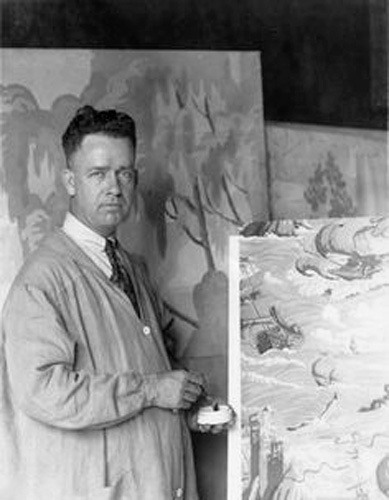 |
Charles E. Burchfield | |
| Birth Date: April 9, 1893 |
||
| Death Date: January 10, 1967 Artist Gallery |
||
| Charles Ephraim Burchfield was a twentieth-century American painter known for his watercolors that captured and celebrated nature in unique, stylized ways. His work can largely be defined by three major artistic periods: his early period, middle period and late period. He worked almost exclusively in watercolor, often with a “dry brush” technique, which gives his paintings an overall sketchy and opaque appearance, as opposed to a more conventional approach.
Burchfield was born in 1893 in Ashtabula, Ohio and raised in Salem, Ohio, where most of his early works were completed and his style developed. In school, he was drawn to literature, specifically about nature; his favorite authors were Thoreau and Willa Carter, who frequently wrote about the American landscape. While he eventually decided to pursue the visual arts as opposed to writing, many of his works feature descriptive pieces on the back, which allude to his formative interests in nature writers.
The years 1915-1921 mark Burchfield’s “early period”, in which his watercolor landscapes are often based on childhood memories, and take on metaphysical, emotional, and transcendental qualities, in which he demonstrated a deep respect and wonder for nature. During this period, he painted constantly, often sketching the view from the windows of his home or during his walks, and turning these sketches into paintings at night. These works are incredibly expressionistic and energetic. In this period, Burchfield created his own visual language to convey the mysticism and often fantastical appearance of nature. He painted such things as light and movement, human moods, motion, experiences, and phenomena such as the sounds of insects and bells, telephone line vibrations, and atmospheric changes.
One of his most formative experiences as an artist was during his time at the Cleveland Institute of Art, mainly because of professor and mentor Henry Keller, a renowned Ohio watercolorist. It was Keller who urged Burchfield to develop his own unique style, which Burchfield later called “romantic fantasy.”
This period was not only when he discovered his artistic style but was also one of the busiest periods of his life. He graduated from the Cleveland Institute of Art in 1916, was briefly assigned to the camouflage unit in the Army in 1918, and after becoming engaged to Bertha Kenreich, he moved to Buffalo, New York in 1921, where he found work at the H.M. Birge wallpaper company. In 1922 he and Kenreich were married, and by 1928, he was a father of four, with a fifth one on the way.
The second period of Burchfield’s work is generally recognized as ranging from the 1920s through the 1940s, where Burchfield departed from the metaphysical and took on a more realistic approach in his landscapes, often focusing not on nature, but city scenes. It is often suggested that the loss of Burchfield’s romantic perspective can be attributed to his time in the army, and the bleak outlook on life it may have given him. With great financial concerns and an expanding family, Burchfield set out to see if he could resign from Birge wallpaper company and make a living as a full-time artist, selling work through the Rehn gallery in New York. He inevitably found success in this endeavor. His work during this time mainly focused on weary small-town and industrial scenes, many of them representing Depression America. His choice of subject matter therefore put him into the Regionalist grouping of artists. These works were much less fantastical than his earlier body of work, and much more subdued, which led some to draw some similarities to Edward Hopper’s work and his portrayal of nostalgia and the American landscape.
Burchfield’s final period from 1943 on marked his inevitable return to the whimsical style that defined his early period. In this period, Burchfield captured the mysteries of nature, such as changing seasons. His works during this period often represent nature in large, overdramatic ways, using swirling strokes, bold colors, and exaggerated forms.
Burchfield garnered significant accolades for his work throughout his life: in 1930, he was featured in a solo exhibition at The Museum of Modern Art in New York, Life Magazine named him one of America’s Ten Greatest Painters in 1936, he was elected to the National Academy of Design in 1952, Buffalo State College dedicated the Charles Burchfield Center in his honor in 1966, and a twenty-nine-acre complex was dedicated to him in West Seneca, New York. His work is included in several collections nationwide, such as the Museum of Modern Art, the Smithsonian, and the Philadelphia Museum of Art. Burchfield passed away in 1967 after a long career and left behind a legacy that impacts and inspires artists today. Few have surpassed his ability to transmit the emotions that nature stirred in him.
|
||


